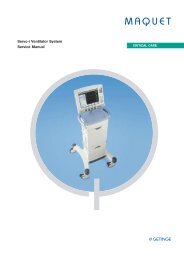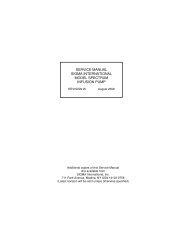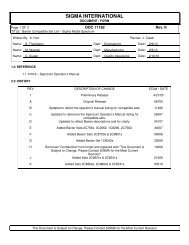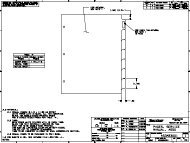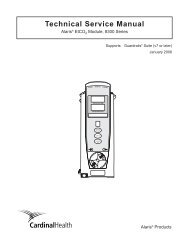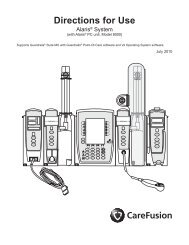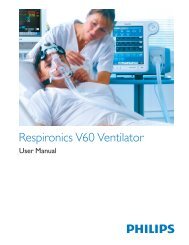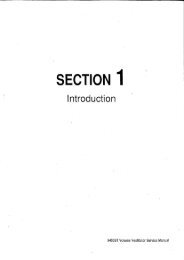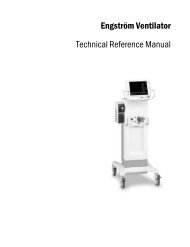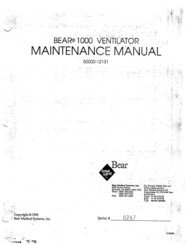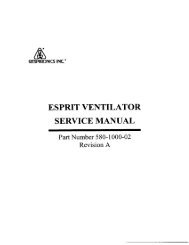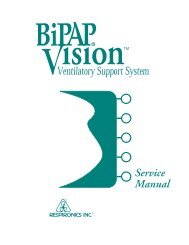Operator's Manual-AVEA - Static Content
Operator's Manual-AVEA - Static Content
Operator's Manual-AVEA - Static Content
You also want an ePaper? Increase the reach of your titles
YUMPU automatically turns print PDFs into web optimized ePapers that Google loves.
Service <strong>Manual</strong> 27<br />
Exhalation Valve<br />
The Exhalation Valve regulates flow out of the patient circuit. Exhaled patient gases<br />
flow through the expiratory leg of the patient circuit, past the Exhalation Valve<br />
diaphragm and seat, and out to the atmosphere. The Exhalation Valve is a<br />
pneumatic servo controlled regulator. Within the Exhalation Valve, Proximal pressure<br />
and Control pressure (which alternates between PIP and PEEP reference pressure<br />
depending on the breath phase) are separated by a Control diaphragm. If Control<br />
pressure is higher than Proximal pressure, the Control diaphragm will move the<br />
control pin to close the Exhalation Valve diaphragm. When Proximal pressure<br />
equals PIP/PEEP Control pressure, the diaphragm will open slightly to maintain the<br />
PIP/PEEP level. At exhalation, Control pressure drops to PEEP reference pressure<br />
which causes the Control diaphragm to retract the control pin opening the Exhalation<br />
Valve diaphragm. Proximal pressure then drops to the PEEP level and stabilizes.<br />
Flow Sensor<br />
The BEAR CUB 750vs Infant Ventilator flow sensor reads gas flow while sensing<br />
flow direction. The flow is calibrated to 37 °C, ambient pressure, and assumes 100%<br />
humidity. Inhaled flows, exhaled flows, and volumes are monitored with control<br />
electronics through the flow sensor. The flow sensor enables the ventilator to trigger<br />
a breath based upon inspired flow. The patient effort (in L/min) required to initiate a<br />
breath can be adjusted (.2 to 5 L/min) using the assist sensitivity setting. The flow<br />
sensor also enables the ventilator to display on the front panel the percentage of<br />
endotracheal tube leak based upon inhaled and exhaled volume measurements.<br />
The flow sensor operates on the principle of hot wire anemometry. The hot wire flow<br />
sensing system is a constant temperature device. The bidirectional operation is<br />
achieved with two platinum wires. The two wires are positioned in the same plane<br />
with a pin installed between them. The upstream wire will cool more rapidly than the<br />
downstream wire. Therefore more current will be required to maintain a constant<br />
preset temperature. The electronics interprets this higher current in the upstream<br />
wire to determine both flow and flow direction. This measured flow rate is then<br />
integrated over time by the ventilator’s microprocessor to yield inhaled and exhaled<br />
volumes.<br />
The flow sensor reads from 0.2 to 40 L/min, calibrated from 0.2 to 25 L/min, and<br />
indicates to 40 L/min. Each Flow Sensor Cable Assembly contains an electronic<br />
memory circuit (an E2PROM) which stores calibration data for the unit. Therefore,<br />
the sensor will function with the electronic circuit of any BEAR CUB 750vs Infant<br />
Ventilator without the need for a system calibration.<br />
Ventilator Electronics<br />
The major components of the electronics system include the Display PCB, the<br />
Control PCB, and the Power Supply.<br />
The Display circuit board is the user interface for the ventilator electronics. Ventilator<br />
controls and alarms are set by the clinician, and Monitors feed current ventilator<br />
status back to the display.<br />
L2342 Revision B November 2004




